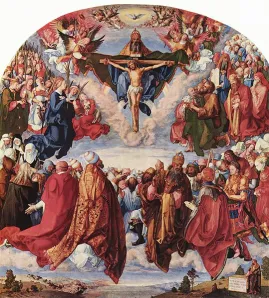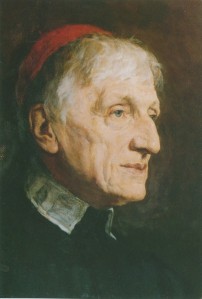Erasmus, born on the 27th October 1466, was a Dutch humanist and theologian, who merits serious consideration by queer people of faith.
Born Gerrit Gerritszoon, he became far better known as Desiderius Erasmus of Rotterdam: Erasmus was his saint's name, after St. Erasmus of Formiae; Rotterdam, for the place of his birth (although he never lived there after the first few years of early childhood; and "Desiderius" a name he gave himself - "the one who is desired".
Erasmus, the "gay icon"?
Some LGBT activists have hailed Erasmus as a gay icon from history.
Circa Club for instance has no doubt, using that precise term and including Erasmus in it's collection of historical gay icons. The primary basis of the claim is a series of
passionate love letters he wrote to a young monk Servatius Roger, and allegations of improper advances made to the young Thomas Grey, later Marquis of Dorset, while employed as his tutor.
Others are unconvinced, pointing out that the nature of friendship between men, and the form of expressions of affection between them, were very different in Erasmus' day to ours. They also point out that there were never any direct allegations of physical relations with Grey, or with anyone else. This argument largely rests on the assumption that in a time of marked public opposition (and official persecution) of "sodomy", any suggestion of homosexual intercourse would have provoked strong denunciation and even prosecution. I am not convinced by either side.
Erasmus was certainly not "gay" in any modern sense. The use of the term "gay icon" for any man of the Renaissance period, and particularly for a priest, is clearly anachronistic, and inappropriate. It is also true that expressions of "love" in the letters to Servatius may be no more than expressions of Platonic affection, expressed a little more effusively (but not much more so) than was customary at the time. We cannot say for certain that he was sexually active with men.
But the absence of proof also does not disprove the hypothesis. As a priest, Erasmus was expected to be celibate. There is also no evidence of sexual relations with women, but that does not disprove that he was heterosexual. The claims that the strong climate of opposition to sodomy "would have" resulted in public exposure are also invalid. Over several centuries, thousands of "sodomites" were tried and executed - but the meaning of the term was vague and variable, including everything from "unnatural" (i,e, anal or oral) intercourse between husband and wife, to witchcraft and heresy, to treason. In post-Reformation England, it was even sometimes used interchangeably with "popery", as Catholicism was also viewed as treason against the English monarchy. In fact, many of those convicted may have been the victims simply of malice and grossly unfair criminal procedures, and completely innocent of sexual non-conformity - and very many more who were indeed engaging in homosexual activities were left entirely unhindered.
The matter of Erasmus' sexual activities is at best undecided - and also irrelevant. To focus on "did he or didn't he" is to make the mistake of the homophobes, who are convinced that homoerotic relationships are all about genital sex. It is enough for me to note that whatever the physical relationship may or may not have been, there was a definite, powerful and emotionally intimate relationship between Erasmus and Serviatus.
I also like this quotation, from his "In praise of marriage":
I have no patience with those who say that sexual excitement is shameful and that venereal stimuli have their origin not in nature, but in sin. Nothing is so far from the truth. As if marriage, whose function cannot be fulfilled without these incitements, did not rise above blame. In other living creatures, where do these incitements come from? From nature or from sin? From nature, of course. It must be borne in mind that in the appetites of the body there is very little difference between man and other living creatures. Finally, we defile by our imagination what of its own nature is fair and holy. If we were willing to evaluate things not according to the opinion of the crowd, but according to nature itself, how is it less repulsive to eat, chew, digest, evacuate, and sleep after the fashion of dumb animals, than to enjoy lawful and permitted carnal relations?
-In Praise of Marriage (1519), in Erasmus on Women (1996) Erika Rummel
Erasmus, the scholarly reformer.
It is not his sexuality that most impresses me, but his legacy as a scholar and church reformer. His career spanned the years leading up to, and after, Luther's break with the Catholic Church that became the Protestant Reformation. Prior to the split, Erasmus had himself been fiercely critical of the Church, arguing forcefully for reform of the many and manifold abuses. He had close relationships with Luther and many other leading members of the Reformation movement, which his ideas strongly influenced. However, when the break came, he chose to remain formally inside the church structures, and not outside of it.
LGBT Christians are often attacked by others for remaining inside a religion which is seen as inimical to gay interests, and so to be siding with the enemy of gay liberation, but this is simplistic. Erasmus' response to the reformers was that it was the abuses that needed to be destroyed, not the church itself - an argument that applies equally strongly to the situation today, in respect of sexuality. The restricted, misguided view of sexuality promoted by some claiming the authority of religion, is not inherent in the Christian religion, but has been imposed on it to promote a particular heterosexual agenda. It is this abuse that we must oppose, not Christianity.
In doing so, we should also learn from Erasmus' methods. Among his criticisms of the Church was its heavy dependence on medieval scholastic theology, with its elaborate structure of speculative philosophy. Instead, he went back to the sources, to build his theology on a sounder structure of evidence. Recognizing the inadequacies of the Latin Vulgate bible, he devoted himself to the study of Greek, and eventually published a more reliable Latin translation (which came to replace the Vulgate, with a parallel Greek text), He also wrote a series of treatises on several of the church fathers.
Queer theologians today are doing something similar. Instead of sitting back meekly and accepting the received ideas on the Bible's supposed condemnation of homosexuality, they have gone back to the roots of Biblical scholarship, closely studying the texts in the original Hebrew and Greek, and paying close attention to the full literary analysis and contextual considerations. They have demonstrated the weaknesses of the traditional interpretations, and have earned the concurrence of many heterosexual colleagues. This reassessment of the Biblical evidence has been one of the important factors in the present moves to greater LGBT inclusion in church, as pastors or in rites for recognizing same-sex unions. Other theologians have resisted the received opposition by ignoring scholastic monolith, and going back to the source of the Christian religion - Christ himself, as revealed in the Scriptures. Others again, emphasise the importance of a personal relationship with God, through prayer, in place of unthinking deference to the human authority of clerical oligarchs.
Erasmus, the man in the middle.
In the build-up to the Reformation, Erasmus aimed to avoid taking sides in the split. His thinking was a definite influence on the reformist cause, and was later accused of having "laid the egg that hatched the Reformation". His response was that he had hoped it would lay a different bird. He worked hard to retain good relationships with both sides and to keep the peace between them, but in the end, his reward was to be viewed with some suspicion and resentment by both sides. By Catholics, for having fostered the reformist thinking in the first place, and by Reformists for having deserted them at the end.
Queer people of faith will sympathise. We too aim to straddle two camps- and are frequently attacked from both sides: by some traditionalists Christians for our supposed sexual sin, and by secular gay activists for siding with the enemy,
May the example of Desiderius Erasmus sustain us in our endeavour.
Related articles at Queering the Church, and at Queer Saints and Martyrs:



















